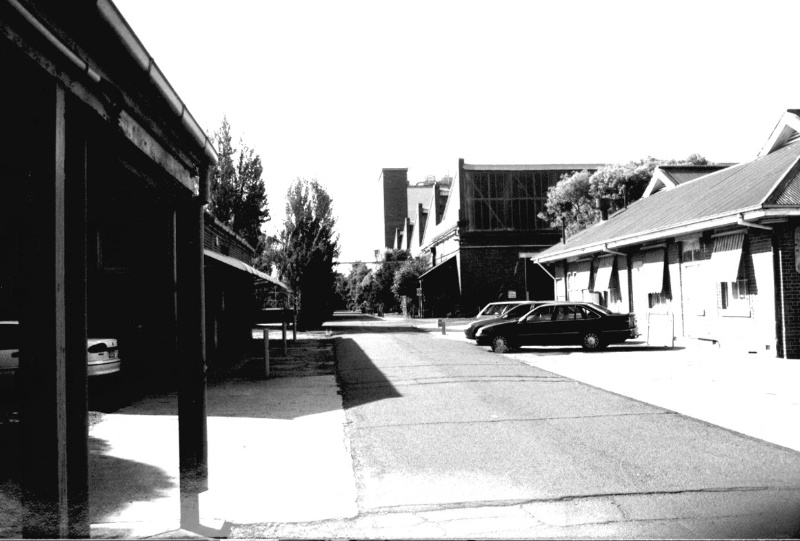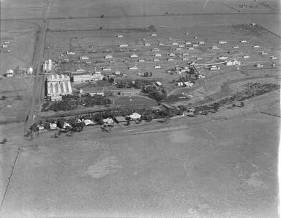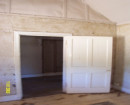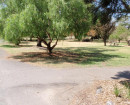Deer Park Explosives factories complex
Ballarat Road, DEER PARK VIC 3023 - Property No 6
ICI Residential Precinct
-
Add to tour
You must log in to do that.
-
Share
-
Shortlist place
You must log in to do that.
- Download report




Statement of Significance
The Deer Park explosives factories complex comprises buildings, structures and landscape features relating to a number of phases of manufacture. It includes remains of the nineteenth century dynamite factory and the former Office and laboratory located in the north east of the site near Kororoit Creek; the initiator and ammunition sections on Tilburn Road; the Leathercloth Factory on Station Road; and remnants of the Federal Fertiliser Factory and Black powder works at the (now discontinued) Fitzgerald Road.
The Deer Park explosives factories complex is of historical, technical, social and aesthetic significance at the state level.
The Deer Park factory complex is of historical significance as the location of the first plant for the manufacture of high explosives in Australia and has been, for its entire history, the most important, if not only, commercial manufacturer of high explosives in Australia. It commenced operation under the importer Jones Scott and Co, and then the Australian Lithofracteur Company (Krebs Patent), a rival to Nobel's dynamite patent. The factory was producing nitro-glycerine based explosives in Australia only a couple of years after Nobel's Ardeer factory began operating in Scotland.
The explosives factories complex is of historical significance for the association with the Australian Lithofracteur Company, Australian Explosives and Chemicals, the Nobel company and later ICIANZ, which grew to become one of the largest explosives, chemical and plastics manufacturers in Australia. It was the pioneer of the industry and retained its dominance through monopolistic practices, taking over most of its competitors in the Australasian region. Substantial parts of the early buildings remain which indicate past and present processes of manufacturing, the necessary safety measures required and the integrated nature of the explosives and chemical industry.
The factory complex is of historical significance for the major role it played in Victoria's manufacturing and mining industries through the development of progressively more efficient and safer explosives. It also contributed to wartime production in ammunition, initiators and the development of synthetic ammonia production and construction of the Defence Explosives Annexe No 5 (later the Albion Explosives Factory) during World War Two.
The factory complex is also of technical significance for the unusual and specialised design of many of the buildings and structures, both in the layout of the works and the individual design of buildings. Blast protection and safety measures such as mounds around the buildings, 'cleanways' and buffer zones between production areas were employed extensively. A characteristic of many production buildings was the elimination of cavities where explosive compounds could lodge. The combination of concrete barriers and light-weight construction was designed to direct explosion debris away from operators or other buildings. The narrow gauge tramway, which ran through the explosives section, is a rare survivor of nineteenth century materials-handling methods.
The Leathercloth Factory is of significance for its architectural and technical values. The Leathercloth Factory was influential in the development of synthetic materials for the motor industry including vinyl seat fabrics and hoods, and has continued to play an important role in synthetic fabrics. The Leathercloth factory was a pioneering enterprise in Australia. No other comparable buildings relating to the same industry from this period survives in the state. Activities in other buildings within the ICI complex at Deer Park produced some of the raw materials used in Leathercloth production. The Leathercloth Factory buildings are also associated with an innovative workers' housing estate with company residences built for the Leathercloth works manager and foremen in Ballarat Road and Station Road (these are included in separate citation).
The building, used variously as office, laboratory, and manager's residence, has important links with significant phases and leading personnel in the factory's history. In its early years (up to the early 1920s), it accommodated a resident manager, an essential requirement of such a dangerous industry. The building took on a new role as 'part of factory offices' in 1926-27, after the construction of a new manager's residence in Ballarat Road, and as a laboratory in later years. It is significant as one of the oldest buildings on the site, with evidence of its former uses, such as the brick reinforcing buttresses added during its use as a laboratory.
The former Federal Fertilizer works, of which some components remain, reflects the process of diversification in the chemical industry where the waste product of one process, in this case dilute acid, can be turned into a commercial product, superphosphate fertilizer. The now demolished main building was interesting as an example of the solution found to the problem of providing large areas of dry storage for phosphates. The timber buildings dominated the Fitzgerald Road approach to the site and were part of the earliest surviving group of structures relating to the important explosives and chemical companies connected with the site. Remaining structures such as the concrete ammonia store and ancillary workshops remain to demonstrate the former layout of the fertiliser section.
The factory complex is also important for its association as a sponsor of unusual workers housing schemes. The housing estates, initiated by Leathercloth Pty. Ltd. in the 1920s and ICIANZ in the 1950s, demonstrate both the patriarchal nature of the ICI company specifically and much of the region's industry generally, and the basic social and economic difficulties of running such an enterprise in a then relatively isolated location.
The ICI Residential Heritage Area is of State historical and architectural significance as a rare and distinctive company township and for its association with the nineteenth century origins and twentieth century expansion of the former Nobel (later ICIANZ, now ORICA) factory which became the major private manufacturer of explosives and munitions in Australia.
The estate, initiated by Leathercloth Pty. Ltd., (a subsidiary of Nobel) is one of a number of company sponsored housing schemes in the Brimbank municipality and reflects a pattern of development where nationally important industries established in green-fields sites beyond the urban fringe and so needed to provide accommodation and other facilities for workers. The inclusion of the recreation reserve in the precinct and the adjacent separately listed Deer Park Hall, and Hunt Club Hotel (a former ICI training centre) further demonstrate the company role in local planning and development.
The precinct is significant for its association with the largest explosives, chemicals and plastics manufacturer in Australia, originally established here under the importer Jones Scott and Co in the 19th century, and then becoming the Australian Lithofracteur Company (Krebs Patent), a rival to Nobel's dynamite patent, and in production in Australia only a couple of years after Nobel's Ardeer factory was opened. It later merged with the Nobel company and then became ICIANZ before the most recent change to ORICA.
This important industry played a major role in mining through the development of progressively more efficient and safer explosives. It also contributed to wartime production in ammunition, initiators and in World War Two, the development of synthetic ammonia production and construction of the Defence Explosives Annexe No 5 (later the Albion Explosives Factory). The Leathercloth plant was influential in the development of synthetic materials for the motor industry including vinyl seat fabrics and hoods, and has continued to play an important role in synthetic fabrics.
The houses in Station Road, Ballarat Road, Hume Street and Hyde Street reflect a sequence of development in their distinctive styles and forms, reflecting the colonial origins of the company in their Indian Bungalow forms as well as giving insight to the social and economic status of their proposed occupants with the larger and more elaborate houses intended for factory managers. The inclusion of concrete houses in the estate also points to the innovation in building in the later period, possibly as a response to war-time material shortages.
The recreation reserve and contemporary (but altered) pavilion are significant in demonstrating the role of the company in providing community services to their workers, and as evidence of the urban design and landscape approaches to company housing in the period.
-
-
Deer Park Explosives factories complex - Physical Description 1
This is a large and dispersed complex of buildings for explosives and chemical production. The earliest buildings were on the south bank of Kororoit Creek in Portion 6, section 22, Parish of Derrimut. The offices of hand-made brick and bluestone and an 1880s boiler house are located near the original main entrance, now Gate 2 off Ballarat Road near the Western Ring Road. The Nitro-glycerine and Detonator sections comprise about 50 buildings with earth and concrete blast mounds, cleanways and a tramway network dating from 1910 on, with expansions in the two wars and the 1950s. The black powder area was added c.1933.
The production buildings are generally constructed using timber frames with timber cladding on the inside only, to prevent any cavities collecting explosives. Blast mounds, built of earth, concrete or cement-filled sand bags, were used around buildings containing dangerous products or processes. Such buildings were also kept small with large buffer zones between them according to safety regulations set out by the UK and Commonwealth Ordnance Committees. Many post 1930 buildings employed laminated timber arched beams. Larger production buildings such as the Leathercloth factory, have brick walls and steel and timber sawtooth roofs.
The former laboratory is situated on the south bank of Kororoit Creek, within Portion 6, Section 22, Parish of Derrimut, near the original main entrance, now Gate 2. The construction is of hand-made brick and bluestone. It incorporates segmental arched openings for the doorways and some original joinery such as double hung sash windows, panel doors and eave brackets. Diaper brickwork is evident in relief around the doors and possible in polychrome effects, although this is painted over. The building has been modified internally and has brick buttresses constructed on the outside of some walls, evidently to reinforce them.
The 1930s explosives factory office near the original bridged entrance road, retains its outward appearance and some original Art Deco detailing such as the company logo over the entrance doorway and timber and plaster mouldings. The contemporary gatehouse on the original entrance road was demolished some years ago, although the roadway, gates and some of the landscaping remain in this area.
The Leathercloth Factory in the south west portion of the site comprises a large complex of mainly red brick buildings with a main saw tooth roof process building and associated chemical plant. While the main factory is of a prosaic design, some associated buildings, particularly the Station Road offices show some flair in a wide verandahed homestead style capped with small onion domed vents. Red brick factory and office complex with corrugated iron roofing and ornamental metal roof vents, ogee roof forms.Deer Park Explosives factories complex - Physical Conditions
Demolition of part of this site occurred in 1997. There is a need to re-inspect. Much of the surviving explosives manufacturing plant is confined to incorporation, mixing and packaging buildings which form a group of small interconnected structures with concrete "cleanways" and narrow gauge tramlines. The nitro-glycerine plant and the c.1910 boilerhouse have, however, been demolished.
Deer Park Explosives factories complex - Historical Australian Themes
3 Developing local, regional and national economies
3.13 Developing an Australian manufacturing capacityHeritage Study and Grading
Brimbank - Brimbank City Council Post-contact Cultural Heritage Study
Author: G. Vines
Year: 2000
Grading: StateBrimbank - Melbourne Western Region Industrial Heritage Study
Author: G. Vines & A. Ward
Year: 1989
Grading:
-
-
-
-
-
BLACK POWDER MILL
 Victorian Heritage Register H2029
Victorian Heritage Register H2029 -
ICI Housing Estate Precinct
 Brimbank City
Brimbank City -
ICI Residential Precinct
 Brimbank City
Brimbank City
-
177 Fenwick Street
 Yarra City
Yarra City -
19 Cambridge Street
 Yarra City
Yarra City -
2 Derby Street
 Yarra City
Yarra City
-
-












